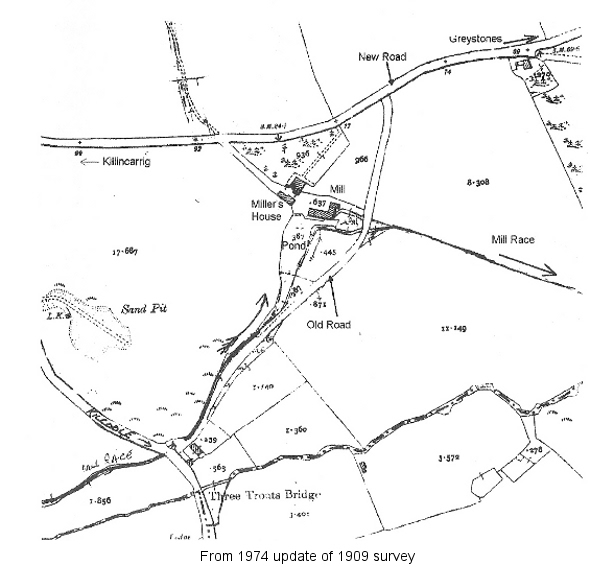Journal Volume 2 1995
The Old Corn Mill, Killincarrig
By Sean Daly
(As written for National Heritage Day on 13 September 1992.)
Introduction
Prior to 1784 Irish agriculture was mostly orientated towards grazing.
In the early 1700's riots occurred because of chronic food shortages. The Irish Government resolved to redress the imbalance in food production and in 1784, the Chancellor, Foster, introduced a law promoting tillage. This was done by giving grants or 'bounties' for the export of grain. To discourage imports a sliding scale of import duties was devised. These levies ranged from 10d a barrel down to 2d a barrel in times of scarcity on the home market. The whole system was biased in favour of the developing Irish economy and was an immediate success. Almost all the grain was sold to England.
Foster's Corn Law, as it was known, produced an agricultural revolution in Ireland. During the French wars, particularly between 1800 and 1815, prices for grain rocketed. Farmers prospered and corn mills sprang up all over the country. Bogs were reclaimed and tillage took place even on the thin layers of soil that covered the mountain sides.
The Royal Dublin Society was established with the aim of promoting improved methods of agriculture, encouraging the development of more modem implements, techniques of crop rotation, fertilizer usage etc. The Society surveyed the country on a county basis, assessing developments and pointing out deficiencies. In his survey of County Wicklow carried out in 1800, the Scottish expert Frazer noted only one corn mill, that at Newtownmountkennedy, and bemoaned the lack of mills in a county with such excellent water resources.
However by 1840 the Ordnance Survey maps clearly show, there are 4 corn mills near Greystones, one at Bellevue Demesne, one at Kilcoole, one at Newtown and one at Killincarrig. All were powered by water.
Killincarrig Mill
The earliest printed reference to Killincarrig mill is in the 1837 Lewis Topographical Directory under the heading of 'Killincarrig'. Killincarrig village, it was noted had 168 inhabitants living in 23 houses. 'Killincarrig House' was the seat of Arthur Jones Esq., who 'has an extensive mill here'.
Later the mill was known as Courtney's Mill and it eventually passed into the Burnaby Estate. It now belongs to Wicklow County Council. The mill is the last remaining of the above four mentioned and with its ivy-clad shell is a haunting monument to a period of prosperity and change in the local economy Through neglect it is now reduced to a dangerous state as witnessed by the enamel warning sign nailed to a nearby chestnut tree The sign, itself an interesting relic of the Burnaby Estate; it states:
"Warning, this old mill run is in a dangerous condition. The public is warned that any person going beyond this fence does so at his her own risk. The owners will not accept Liability for any damage suffered by such person as a result.
The Trustees Burnaby Estate"


